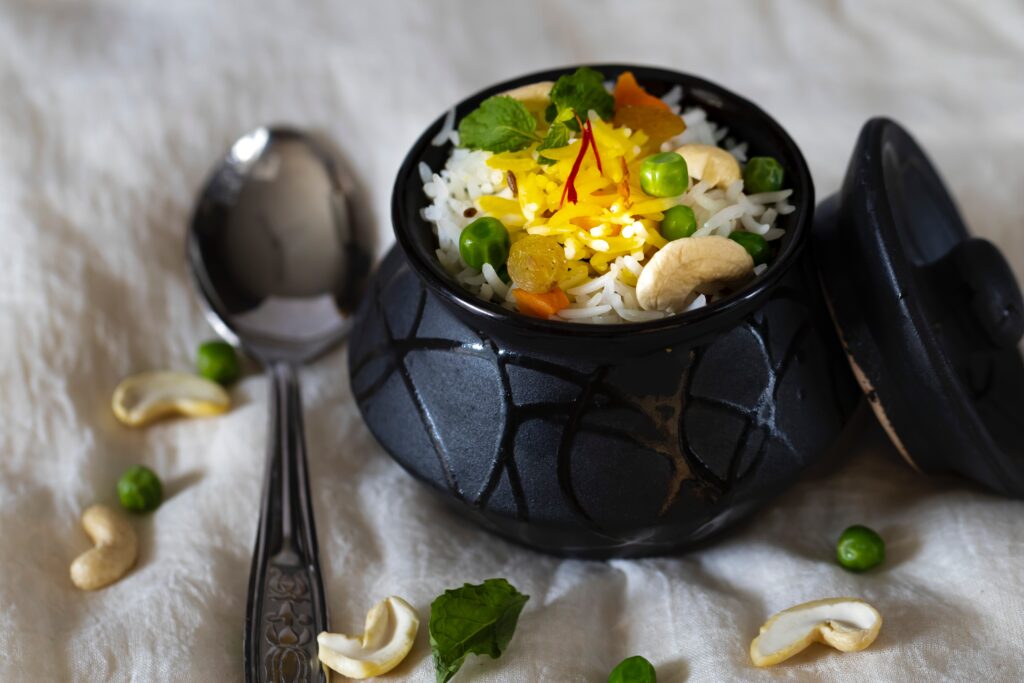Background
Long, slender-grained aromatic rice known as basmati is mostly farmed in India, Pakistan, and Nepal. As of 2019, Pakistan made up the remaining 35% of the global basmati rice trade, with India accounting for 65% of it. Although basmati rice is cultivated domestically in many nations, it is only grown in certain regions of Pakistan and India.
The Indian government agency APEDA states that among other requirements, a rice variety can only be named basmati if it meets the minimum average precooked milled rice length of 6.61 mm (0.260 in) and the maximum average precooked milled rice width of 2 mm (0.079 in).
Production and Cultivation
Over 70% of the world’s basmati rice is produced in India. Only a minor fraction of that is organically farmed. Increased production of organic basmati rice is being sought by organizations like Kheti Virasat Mission in the Indian state of Punjab.
In India –
The Indian states of Punjab, Haryana, Himachal Pradesh, Delhi, Uttarakhand, Western Uttar Pradesh, and Jammu & Kashmir are those where basmati rice production has a geographical connotation.
In Pakistan –
The original Basmatic region of Pakistan is in the Kalar bowl between the Chenab and Ravi rivers.
In Indonesia –
Indonesia generates its regional variety of basmati in West Java and Central Kalimantan.
In Nepal –
The Terai region of Nepal and some areas of the Kathmandu valley are where basmati rice is mostly grown.
In Sri Lanka –
In Sri Lanka’s tropical wet zone regions, small amounts of basmati rice, particularly red basmati rice, are grown.
Health Benefits of Basmati Rice
Both brown and white basmati rice has several health advantages, such as:
Diabetes
Basmati rice has a substantially lower glycemic index than many rice varieties, especially white rice. Basmati rice is a food with a moderate to the medium glycemic index, falling between 50 and 58. Small servings of basmati rice can be a part of a balanced diet if you have diabetes.
Fiber
Basmati rice can have a high level of fiber in addition to having a lower glycemic index; just make sure you read the nutrition label. Increased dietary fiber consumption can lower the incidence of Type 2 diabetes.
Constipation and other digestive problems might result from a low-fiber diet. Because the fiber in basmati rice is soluble, it provides bulk and aids in the movement of waste through the digestive system.
Better Heart Health
A decreased risk of heart disease has been associated with eating healthy grains like brown basmati rice. Blood cholesterol levels are decreased by eating whole grains. They also assist in lowering blood pressure, which is a risk factor for heart disease.
Reduced Risk of Cancer
In comparison to white basmati rice, brown basmati rice contains 20% more fiber overall. Diets with more fiber can lower your chance of getting some malignancies, especially colorectal cancer.
Better Brain Health
In comparison to white basmati rice, brown basmati rice contains 20% more fiber overall. Diets with more fiber can lower your chance of getting some malignancies, especially colorectal cancer.
How to Prepare Basmati Rice
Many supermarket stores carry dry basmati rice. You must thoroughly rinse it before cooking it. Add a few inches of water to a container containing the necessary quantity of dried rice. To release the starches and drain the water, swish it around. Use a fine-mesh strainer to drain the rice after repeating this procedure until the water is essentially clear.
Fill a saucepan with water and then add the rice. 1.5 to 1.75 cups of water should be added to every cup of rice. The mixture should boil. Then, reduce the heat to low and cover the pot. For 15 to 20 minutes, simmer the rice to let it absorb the water. Remove the saucepan from the heat when the rice is mushy, then leave it alone for an additional five minutes. Use a fork to fluff the rice before serving.
Brown or white basmati rice is a wholesome side dish that goes well with curries, soups, and a range of other cuisines.
Interested in making your basmati dish? Try out these suggestions:
- Vegetables with a protein in a stir-fry (such as chicken or tofu)
- Combine with fresh ginger, turmeric, and coconut milk.
- For a full protein, combine with black beans.
What Does it Taste Like?
In contrast to many other types of rice, basmati rice has a nutty, flowery, and mildly spicy flavor. It has a pleasant perfume but is still moderate in comparison to other, more savory components. The soft grains remain separate and lack stickiness when they are cooked correctly. The rice complements but does not overpower mild and tasty curries and meals.
Conclusion
In conclusion, Basmati rice is a kind of long-grain rice that is primarily cultivated in Pakistan and India’s Himalayan area. It has a distinct scent, a delicate texture, and a nutty flavor. In addition to being a healthy source of complex carbohydrates, basmati rice also has a low fat and cholesterol content. Overall, adding it to any meal may be a tasty and healthy choice.

